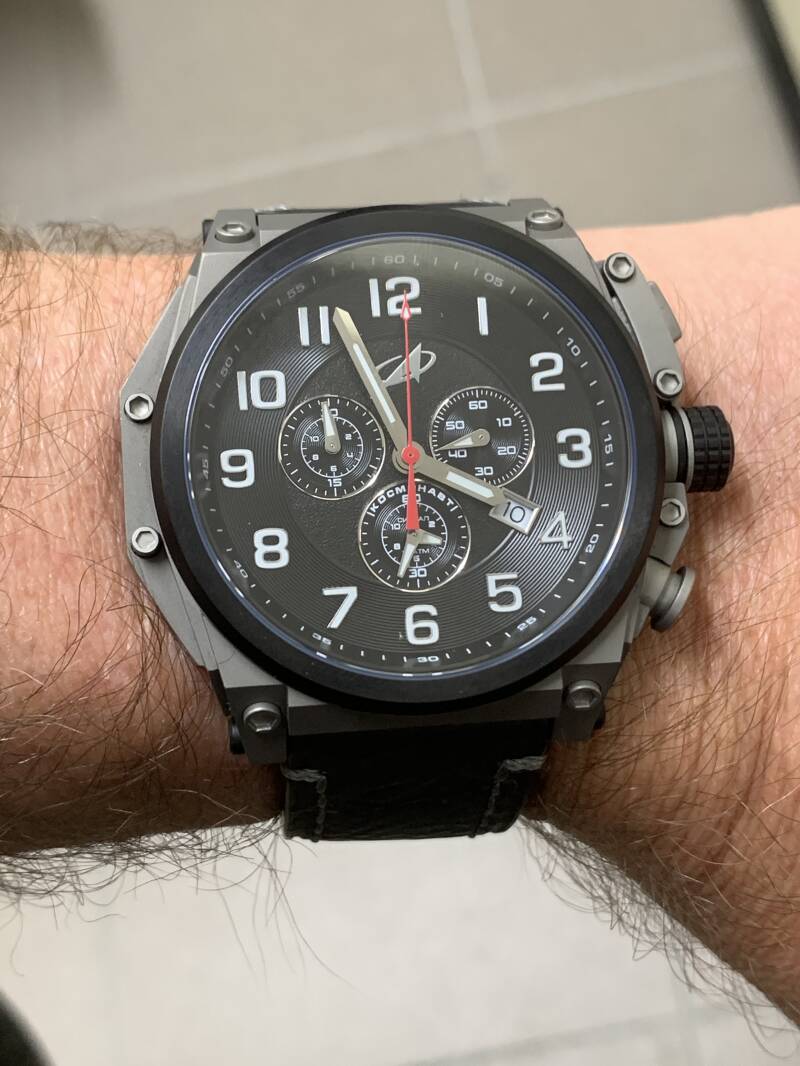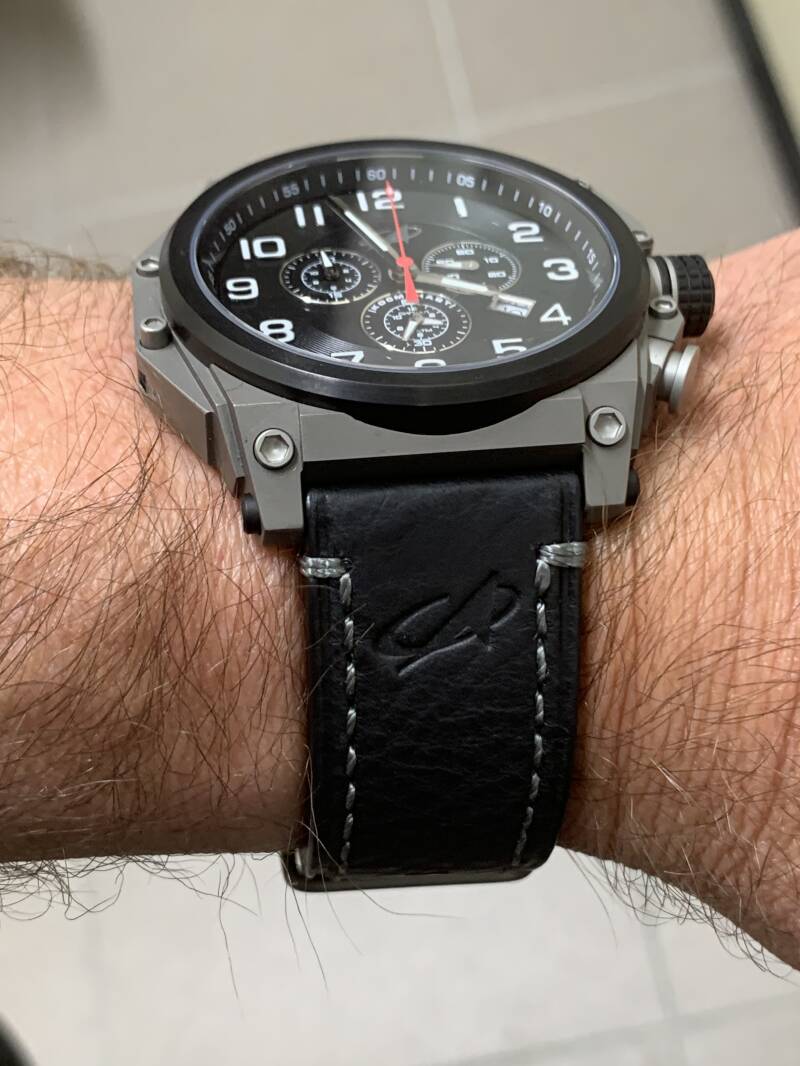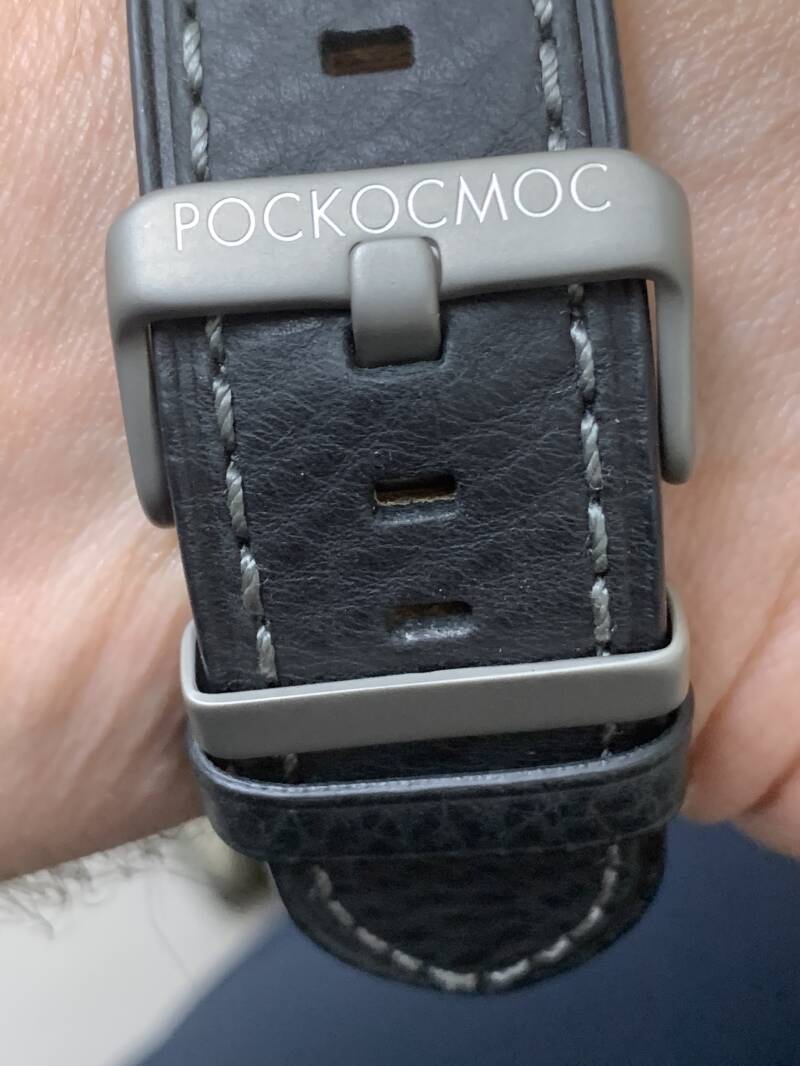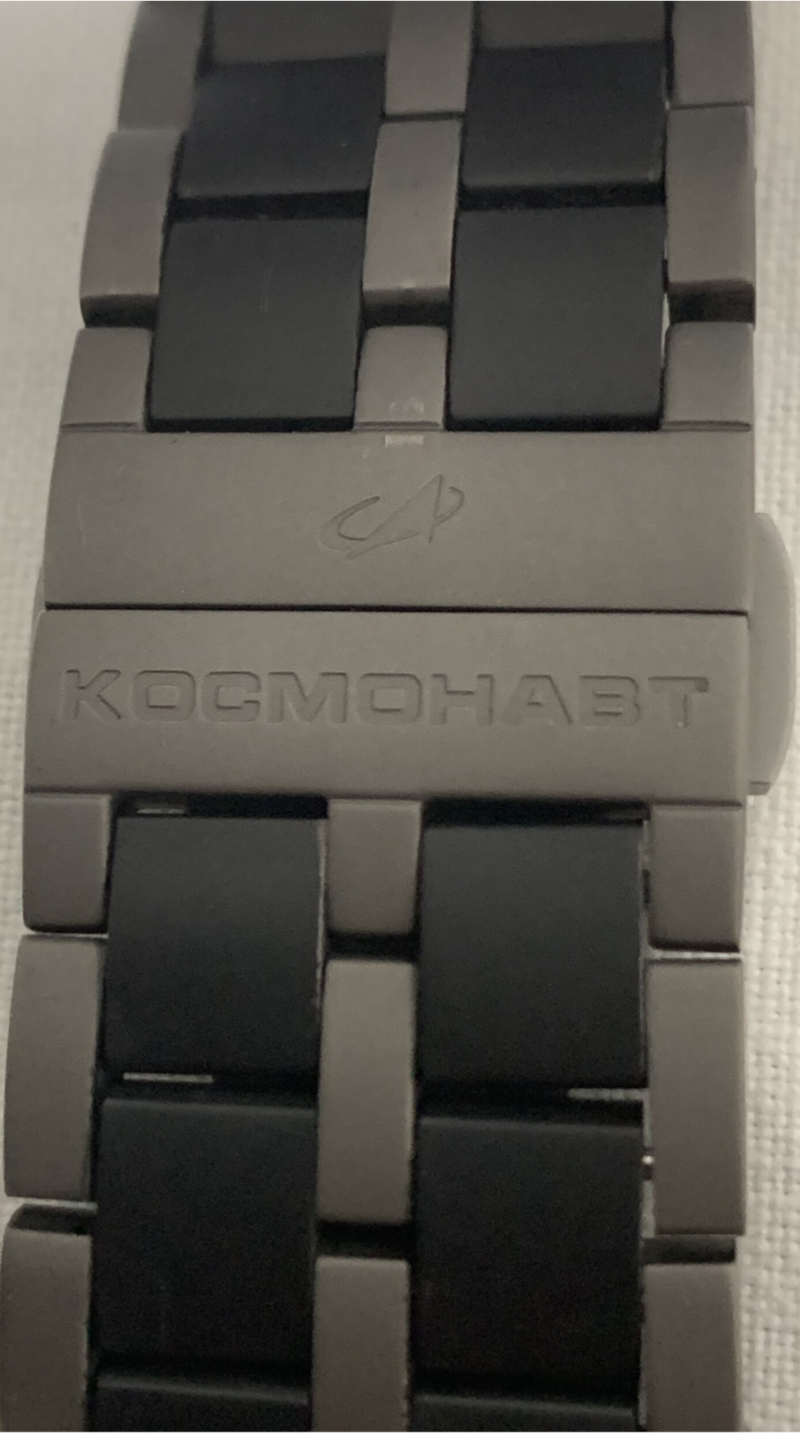Today, I would like to present a very interesting and monstrous watch from the brand Specnaz. Although this brand has already been featured on my website, I believe that for the vast majority of readers, it remains relatively unknown. Therefore, I will begin this review with a brief introduction to the brand and the company behind it.
The watch company Verny Hod (meaning "Right Move") is a Russian watch manufacturer founded in 2000. Shortly thereafter, they acquired the Derzhava trademark, which had first appeared in 1993. Production of watches under the Specnaz (Spetsnaz) brand began after 2002. In 2007, another brand, Petroff, was introduced. Since 2005, Trade House Slava has been the exclusive distributor of all Verny Hod watches, and all the mentioned brands are sold solely under the TH Slava umbrella. As a result, it is a common—but incorrect—assumption that Specnaz is part of the TH Slava brands.
In 2004, Verny Hod, in cooperation with cosmonaut Vladimir Janibekov (also spelled Dzanibekov), developed a very interesting space watch called "Kosmonavigator," featuring the 24-hour Vostok 2423 movement. The 24-hour dial helps cosmonauts determine the spacecraft's position over the Earth. The watch was released as a limited edition of 350 pieces. A very informative article about the watch can be found here:
https://www.safonagastrocrono.club/cosmonavigator-a-true-space-watch/
To be quite honest, I don’t believe cosmonauts actually used this watch in practice. I suspect the watch was taken into space by two cosmonauts purely for marketing purposes and as a favor to their colleague Janibekov. The Vostok 2423 movement belongs to the 24xx family, which is of rather low quality—even by Russian/Soviet standards—and hardly suitable for serious space missions. Nevertheless, the exact watch shown in the article was auctioned off for $32,000. The winner of the auction, now the owner of the watch, is also shown in the article.
The article also references a reissue of the watch. However, the final statement regarding the unknown origin of the "Kosmonavigator II" is inaccurate. Kosmonavigator II was issued by the same company, Verny Hod, as the original version. It is also incorrect to say that the reissue lacks a 24-hour display. While the dial is indeed a standard 12-hour layout, the watch includes a 24-hour hand, which serves the same purpose by indicating the spacecraft's position on the bezel. This reissue uses the Miyota 6M17 quartz movement, featuring three hands—one of which is a 24-hour hand—and a date complication. Notably, the reissue does not feature any Roscosmos branding, unlike the original version.
As one can conclude, the company has experience in developing space watches and has had a real connection with the Roscosmos space agency in the past (and as you will see later on, that is the main reason why I spent so much time explaining the history of the Kosmonavigator watch).
Later, the Specnaz brand evolved into a producer of distinctly military-style watches. Even the brand name itself suggests that these watches are intended for use by special task forces of the Russian army. In fact, some lines of watches were developed in close cooperation with Specnaz units.
With that background in place, it’s finally time to begin the review of the watch: Specnaz 5 Stikhiy Kosmonaut.
First, I owe you an explanation of what "5 Stikhiy" means. As stated in the title, "5 Stikhiy" translates to "5 basic elements." The concept of five basic elements is common in ancient cultures, although the elements themselves differ from one tradition to another. Specnaz adopted what appears to be a Buddhist version (possibly shared with other traditions), in which the five elements are Fire, Water, Air, Earth, and Space. They developed five models in the "Spetsnaz 5 Elements" series, with each model representing one element. Each element/watch is dedicated to one of Russia’s main military branches: Fire – Ministry of Emergency Situations – Rescuers; Water – Navy – Marines; Air – Airborne Forces – Paratroopers; Earth – GRU – Reconnaissance; Space – Roscosmos – Cosmonauts

All five series are limited, with only 100 watches produced per model, and each piece is individually numbered.
Even though the five versions are dedicated to specific military forces, they do not differ significantly—generally only in the color of the dial, case, and bracelet. Each element also features its own specific military insignia on the dial and backplate. Since I am a space watch collector, I naturally chose the Kosmonaut version, and my review is based on the Space-element model. To me, this version also happens to look the best out of the five (in fact, I chose it as my favorite before realizing it was the Space model)—but of course, that’s highly subjective.
I ordered the watch online without having seen it in person. And although it already appears large in the pictures, it’s still a shock when you see it in real life. The 50mm case diameter is massive (measured without the crown, crown protector, or pushers on the right side of the case), and the built-in flashlight on the left side adds another 1.6 cm. To top it off, there’s also a small secondary watch mounted on the bracelet…
When ordering it, I genuinely wondered whether the watch would be wearable at all. And with everything going on, I’m being generous when I say: yes, but barely. Fortunately, one redeeming factor is that the watch isn’t particularly thick—it’s only 12mm—which helps it feel slightly more manageable. Take a look at how it wears on my 19 cm wrist...




Why did I emphasize “everything”? Well, the designers of this watch were clearly aware that it would not be wearable in its full configuration for 99.9% of the population. So here’s the first good thing: the flashlight can be easily removed without any tools. You simply press a small button and slide the flashlight off. Easy.
Next, the package includes an additional leather strap and the tools needed to swap the bracelet for the strap. Yes, a special tool is required because the bracelet is not attached to the case with classic spring bars but with threaded bushings—clamps. When replacing the bracelet with the strap, you also remove the secondary watch, as it is integrated into the bracelet.
After these two steps, what you’re left with is a chronograph that is still large, but now wearable—and perfectly suitable as an everyday watch. Here's the same watch on my wrist before and after all of these modifications.








But that’s not all. You also receive a NATO Velcro/leather strap, which is huge and clearly intended to be worn over a spacesuit. Very practical. :)
Although the watch is massive, it’s surprisingly not heavy. The total weight with the bracelet adjusted to my wrist size is just 130 grams. I’ve been wearing it for a while now, and I find it very comfortable. The case and bracelet are made of titanium, which—in my opinion—is a great choice. I like titanium watches, although I know many users prefer stainless steel. In this case, though, steel would probably make the watch far too heavy.
The bracelet itself is very good, with one small complaint: the integrated secondary watch doesn’t contribute to ease of wear. Since it’s a fixed element near the lugs, the bracelet doesn’t wrap smoothly around the wrist—in other words, the watch sits slightly off-center. It would have been much better if the small watch had been integrated as a large removable link, like the others. That said, after testing all available configurations, I ultimately chose the bracelet as my preferred option—so clearly the decentralization isn’t a dealbreaker.
Adjusting the bracelet is easy; the links are simple to remove using standard tools for pushing bracelet pins. The bracelet also features a double-deployment clasp, meaning there is no micro-adjustment, which is a downside. The leather strap, on the other hand, is thick but soft and comes with a standard pin buckle.



Both watches feature sapphire glass with anti-reflective coating. The main watch has good illumination on all the numerals, hands, and even the subdials, while the smaller watch has no lume at all.
Moving on to the flashlight—it’s not particularly powerful. It provides enough light to illuminate small objects at close range or to light your path in the dark, but nothing more than that. So, I wouldn’t call it especially useful. The flashlight is powered by four LR41 button cell batteries, which are easy to replace when needed.

Both watches are powered by quartz movements. The main watch uses the Ronda 5130.D, though I wasn’t able to find any specific information about the movement in the smaller watch (aside from the fact that it is also Swiss-made).
The Ronda 5130.D is an interesting chronograph movement that includes an alarm complication. The chronograph has a combined totalizer for minutes and hours and can measure up to 12 hours (shown on the left subdial). It supports accumulated timing, interval timing, and intermediate timing. Being a quartz movement, adjusting any misaligned hands is relatively easy.
The lower subdial is used for the alarm function. In the crown’s standard position, it shows the alarm time (which can be set up to 12 hours in advance), but I must say that setting the alarm is not particularly intuitive. The alarm uses its own internal "reference time" clock, and you must ensure that this reference time aligns with the actual time shown on the main dial. If it doesn’t, you may find yourself surprised when the alarm doesn’t go off as expected!




As someone who also collects mechanical alarm watches—which always use the main time as the reference—I find this separate internal clock setup quite annoying. That said, the alarm is fairly loud, and turning it on or off is simple: just press the lower chronograph pusher.
The watch comes in a robust, heavy-duty waterproof case.
As you can see from all the pictures, the watch is marked with the Roscosmos symbol throughout—either as a hallmark, as text, or both. The caseback is no exception.
I don't believe that Roscosmos currently uses, or will ever actually use, this watch for its cosmonauts. However, I am quite confident that Roscosmos has officially approved the use of its insignia. In that sense, the watch serves as a respectful tribute to all Soviet and Russian cosmonauts and their achievements in space. My guess is that the story of the Kosmonavigator, mentioned at the beginning of this article, played a significant role in securing that connection.
My overall impression of the watch and its quality is extremely positive, and I have no serious complaints regarding its final presentation. It is well crafted and gives the impression that serious quality control and attention to detail were applied. However, as usual, I must say something about the price. The full price of the watch in Russia is 125,000 RUB (approximately €1,400), and in the EU it costs €1,620 including all taxes. Even though the watch is made entirely of titanium, including the bracelet, and comes with two additional straps, sapphire crystal, and a premium case, it is still expensive for a quartz watch. For comparison, the former Russian and now Swiss company Aviator used the same Ronda movement in their Mig-29 collection, and the EU retail price for that watch was around €650. (Aviator later replaced it with the Mig-29 SMP model, which uses the Ronda 5030 movement without an alarm instead of the 5130, and the new model costs €750.) I deliberately reference Aviator because the company has Russian roots and its quality can generally be compared to Specnaz. Of course, a direct comparison is not entirely fair due to the titanium case and bracelet and other features of the Kosmonaut watch. Still, a price that is 2.5 times higher is a considerable difference.
Fortunately, I was able to get this watch much cheaper. On Victory Day (May 9th), the Slava web shop (as mentioned earlier, the exclusive distributor of Specnaz watches) offered a 30% discount, and I managed to purchase the watch for €1,230 including all taxes. In my opinion, that is a fair price for this timepiece.
If you are interested in buying it, you can find it:
in the EU: https://www.maier-uhren.de/speznas/speznas-special-editions/5-elements/c9155340-5130d.html
directly from Slava: https://slava.su/s9155340-5130-d-chasy-naruchnye-specnaz-kvarcevyy-hronograf-kosmonavt
or here: https://smirs.com/russian-watches/spetsnaz/collection-5-elements/c9155340-5130.d/
All listed shops offer worldwide shipping.
If you buy from Slava or Smirs, please note that the instruction manual is only in Russian and written in Cyrillic. I don’t know about the Maier shop, but I assume the manual is available in both German and English. I can highly recommend all of the listed stores, as I’ve had very positive experiences with each of them. These recommendations are based entirely on my own personal experience. As mentioned, I bought the Kosmonaut from Slava, and all their consultants were very helpful (I always use the chat function when ordering). There were no issues with the ordering process or delivery to the EU—everything worked smoothly.
Add comment
Comments
A very extensive and detailed review. It's a pleasure to read.